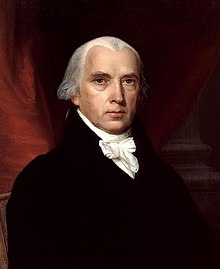|
United States of America
James Madison – 4th President
1970 Proof Silver Medal 39mm (33.01 grams) 0.925 Silver
JAMES MADISON 1809 FOURTH PRESIDENT OF THE UNITED STATES 1817, James facing 2/3 right.
JAMES MADISON BORN MAR. 16, 1751. MARRIED DOLLEY TODD, 1794. A SOFT-SPOKEN SCHOLAR FATHER OF THE CONSTI-TUTION AND THE BILL OF RIGHTS; LAST OF THE FOUNDERS OF THE REPUBLIC. DIED JUNE 28, 1836., Eagle with arrows in claws right atop American shield with stripes and stars.
You are bidding on the exact item pictured, provided with a Certificate of Authenticity and Lifetime Guarantee of Authenticity.

James Madison Jr. (March 16, 1751 – June 28, 1836) was an American statesman, diplomat, and Founding Father who served as the fourth president of the United States from 1809 to 1817. He is hailed as the “Father of the Constitution” for his pivotal role in drafting and promoting the Constitution of the United States and the Bill of Rights.
Madison was born into a prominent planter family in Virginia. He served as a member of the Virginia House of Delegates and the Continental Congress during and after the American Revolutionary War. Disillusioned by the weak national government established by the Articles of Confederation, he helped organize the Constitutional Convention, which produced a new constitution. Madison’s Virginia Plan served as the basis for the Convention’s deliberations, and he was one of the most influential individuals at the convention. He became one of the leaders in the movement to ratify the Constitution, and joined Alexander Hamilton and John Jay in writing The Federalist Papers, a series of pro-ratification essays that was one of the most influential works of political science in American history.
Madison emerged as an important leader in the House of Representatives and was a close adviser to President George Washington. During the early 1790s, Madison opposed the economic program and the accompanying centralization of power favored by Secretary of the Treasury Hamilton and organized the Democratic–Republican Party in opposition to Hamilton’s Federalist Party. After Jefferson was elected president, Madison served as his Secretary of State from 1801 to 1809. In that position, he supervised the Louisiana Purchase, which doubled the size of the United States.
Madison contested the 1808 presidential election and won the presidency. After diplomatic protests and a trade embargo failed to end British seizures of American shipping, he led the United States into the War of 1812. The war was an administrative morass and ended inconclusively, but many Americans saw it as a successful “second war of independence” against Britain. As the war progressed, Madison was re-elected in 1812, albeit by a smaller margin than in the 1808 election. The war convinced Madison of the necessity of a stronger federal government. He presided over the creation of the Second Bank of the United States and the enactment of the protective Tariff of 1816. By treaty or through war, Native American tribes ceded 23 million acres of land to the United States under Madison’s presidency.
In 1817, Madison retired from public office after the end of his presidency, and returned to his plantation, Montpelier, and died there in 1836. Like Jefferson and Washington, Madison was a wealthy slave owner who never privately reconciled his republican beliefs with his slave ownership. Forced to pay debts, he never freed his slaves. Madison is considered one of the most important Founding Fathers of the United States, and historians have generally ranked him as an above-average president, although they are critical of how Madison executed the War of 1812.
|











